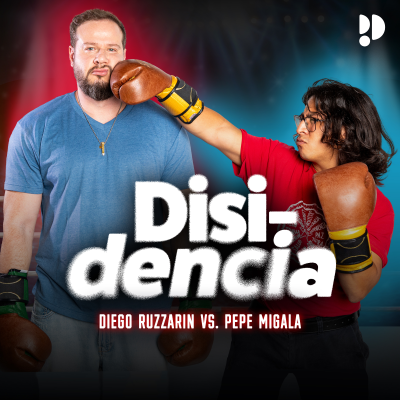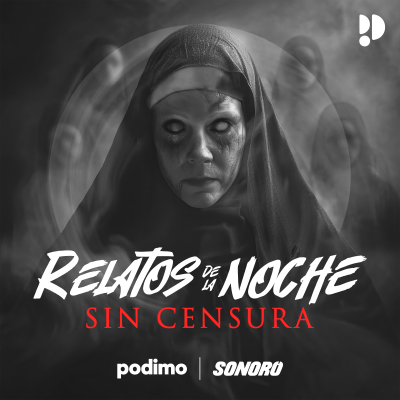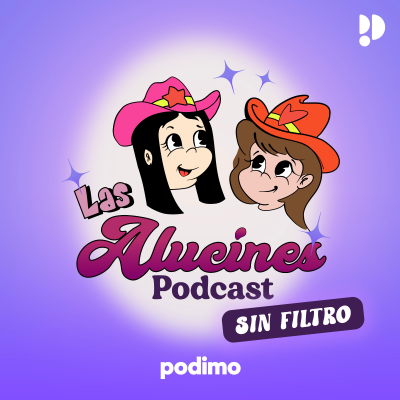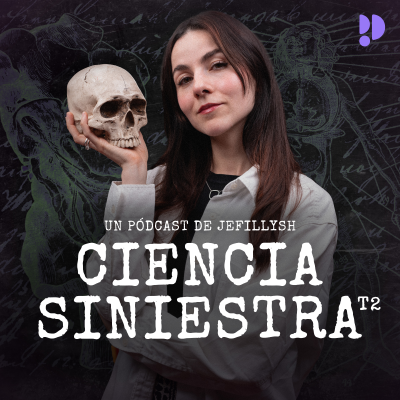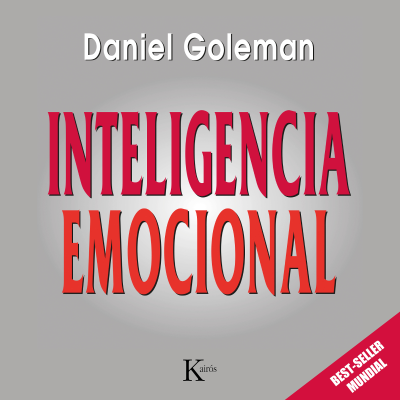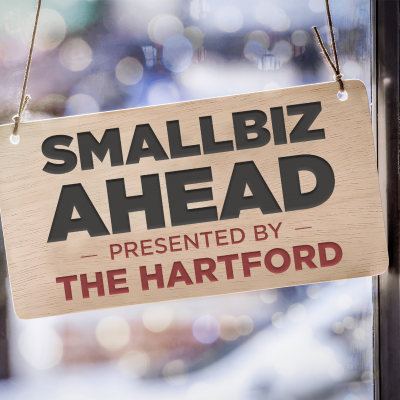
Small Biz Ahead | Small Business | Starting a Business
inglés
Negocios
Empieza 7 días de prueba
$99 / mes después de la prueba.Cancela cuando quieras.
- 20 horas de audiolibros al mes
- Podcasts solo en Podimo
- Podcast gratuitos
Acerca de Small Biz Ahead | Small Business | Starting a Business
The Small Biz Ahead podcast is dedicated to helping small business owners succeed. Each episode focuses on specific topics that can help you bring your small business to the next level. Gene Marks, an author and business owner hosts our podcast with Jon Aidukonis, a specialist in marketing and advertising. Our co-hosts offer insight on how to make your business more efficient with tips, interviews and conversations with business owners and thought leaders.
Todos los episodios
187 episodiosThe State Small Business Credit Initiative: Here’s What You Need to Know
TRANSCRIPT The views and opinions expressed on this podcast are for informational purposes only, and solely those of the podcast participants, contributors, and guests, and do not constitute an endorsement by or necessarily represent the views of The Hartford or its affiliates. You’re listening to the Small Biz Ahead podcast, brought to you by The Hartford. OUR SPONSOR This podcast is brought to you by The Hartford. When the unexpected strikes, The Hartford strikes back for over 1 million small business customers with property, liability, and workers compensation insurance. Check out The Hartford’s small business insurance at TheHartford.com. Gene (00:02 [https://www.temi.com/editor/t/bLi1YaQLn7gL73BBPW7W1dSjrncWRqOeSJoe45UYNGaZf1W6fSq2LduT-e9CHxnYdadpiCSVar6qCENGw_tcBHt7SFc?loadFrom=DocumentDeeplink&ts=2.46]): Hey everybody, this is Gene Marks and welcome to this week’s edition of The Hartford’s Small Biz Ahead podcast. Thanks for joining me. By the way, if you want any advice or insights or help in running your business, please visit us at SmallBizAhead.com, that’s SmallBizAhead.com or SBA.TheHartford.com. And let’s get to the topic at hand. And the topic is a big one for you, if you’re running a small business. It has to do with federal funding that it is available for you. Now, listen, very recently the Senate unfortunately rejected legislation that could have potentially provided small businesses, particularly restaurants with as much as 48 billion dollars of additional aid to help them recover from the pandemic. So, a lot of people are saying, is this it? Is this the end of federal aid? The Paycheck Protection Program and the Economic Injury Disaster Loan programs are both expired. Gene (00:56 [https://www.temi.com/editor/t/bLi1YaQLn7gL73BBPW7W1dSjrncWRqOeSJoe45UYNGaZf1W6fSq2LduT-e9CHxnYdadpiCSVar6qCENGw_tcBHt7SFc?loadFrom=DocumentDeeplink&ts=56.06]): It seems like there’s no more money coming from the federal government to help small businesses. So is that it? And the answer to that question is no. In fact, just these past couple weeks there has been the launching of a new program. Well, let’s say it’s a version 2.0 of a program that’s called The State Small Business Credit Initiative or SSBCI from the federal government. And this is what you gotta know about it. It is 10 billion dollars of new money that the federal government is making available to small businesses across the country in the form of either loans at market or below market rates or grants for your business or equity investments as well. 10 billion dollars in my area where I live in Philadelphia, it’s more than half a billion dollars. What it’s done is it was divided up among all the states based on their employment and other factors. Gene (01:57 [https://www.temi.com/editor/t/bLi1YaQLn7gL73BBPW7W1dSjrncWRqOeSJoe45UYNGaZf1W6fSq2LduT-e9CHxnYdadpiCSVar6qCENGw_tcBHt7SFc?loadFrom=DocumentDeeplink&ts=117.28]): And the money itself is being distributed to the states as well. This is money for you to take advantage of. Now, let’s just make sure that we’re clear on some of the facts. It’s federally backed. All right. So like I said, 10 billion dollars has been made available. It’s really an extension of a prior program, which I’ll talk about in a minute, but let me explain to you what this SSBCI is, or State Small Business Credit Initiative. It’s a program where the U.S. Treasury Department distributes money to the states who then turn around and distribute the money to local lending and financing organizations. Things like community development financial institutions, CDFIs, or community banks or minority depository institutions, as well as investors and other non-profits that are focused on economic development. This money is being distributed to all of these organizations in order to help like local small businesses get access to capital that they otherwise wouldn’t… Gene (02:58 [https://www.temi.com/editor/t/bLi1YaQLn7gL73BBPW7W1dSjrncWRqOeSJoe45UYNGaZf1W6fSq2LduT-e9CHxnYdadpiCSVar6qCENGw_tcBHt7SFc?loadFrom=DocumentDeeplink&ts=178.83]): Have been able to access. Now, a little history here, back in 2011, more than a billion and a half dollars were issued through this program. This is not a new program. And that aid was like snapped up really quick by entrepreneurs across the country. This new program, which was signed into law over a year ago, March of 2021. And the funding is now just coming out. It was part of the American Rescue Plan Act. It reauthorized the original program and instead of a billion and a half dollars being available to small businesses, 10 billion dollars has been made available. All the money has not been distributed yet. There’s still some back and forth in Washington around timing and finalized amounts. But I spoke to representatives at the treasury department. They tell me that the funds just are rolling out soon, this summer to the states and then from the states to participating community organizations. Gene (03:52 [https://www.temi.com/editor/t/bLi1YaQLn7gL73BBPW7W1dSjrncWRqOeSJoe45UYNGaZf1W6fSq2LduT-e9CHxnYdadpiCSVar6qCENGw_tcBHt7SFc?loadFrom=DocumentDeeplink&ts=232.31]): This program is gonna provide funding for organizations which like yours, which you may not been able to get funding like this before and the money’s gonna be going out through these community reinvestment type of organizations, financing firms who better understand the business owners in their local areas. The question is, where do you go to get this money? Well, first I want you to just be careful about what kind of money that you want. Again, there are loans available for you. There are grants available for you. There are even equity investments in your business available for you. The best thing that you should be doing is you should be Googling SSBCI and your state or State Small Business Credit Initiative and your state. Gene (04:40 [https://www.temi.com/editor/t/bLi1YaQLn7gL73BBPW7W1dSjrncWRqOeSJoe45UYNGaZf1W6fSq2LduT-e9CHxnYdadpiCSVar6qCENGw_tcBHt7SFc?loadFrom=DocumentDeeplink&ts=280.73]): And that will immediately start giving you some resources in your state to find where you can reach out. These are organizations getting this money. The other place you might wanna try is The Council of Development Finance Agencies State Resource’s map. I know it’s a big one. Their website is CDFA.net. Look for their state resources map. These are all of these different finance agencies around the country. They’re gonna be getting these state funds, which came from the federal government. And these organizations are looking to turn around and lend these monies out or invest this money in businesses in their local areas. Now, remember, these are not traditional loans. This money can be used for venture capital programs where investments will be made in like startups and other early stage companies. Some will be in loan participation programs where like an organization buys an interest in the loans made by a traditional banker or by a private lender. The money can be used to guarantee loans that are given by banks as well. They can be used to help you with collateral if you don’t have enough collateral for a loan with a traditional bank and also capital access. I mean, it’ll provide insurance and capital funds for you. So you wanna look for… Gene (05:56 [https://www.temi.com/editor/t/bLi1YaQLn7gL73BBPW7W1dSjrncWRqOeSJoe45UYNGaZf1W6fSq2LduT-e9CHxnYdadpiCSVar6qCENGw_tcBHt7SFc?loadFrom=DocumentDeeplink&ts=356.839]): Companies in your area, again, community bankers, CDFIs, minority depository institutions or just nonprofits that do economic development in your area. They’re the ones that are getting the money, right? And they’re the ones that wanna turn out and lend this out. Now, the other thing, I just wanna make sure that there’s, sometimes there’s a misconception. This is not like a minority interest thing. Minority businesses will certainly get some preferences in some of these programs but really all businesses are open for getting this kind of help. The idea of this money is to fund businesses that otherwise wouldn’t get traditional funding and of course help you hire people and create more jobs. So because of that, the financing requirements are less stringent than the requirements of a traditional bank loan. Gene (06:46 [https://www.temi.com/editor/t/bLi1YaQLn7gL73BBPW7W1dSjrncWRqOeSJoe45UYNGaZf1W6fSq2LduT-e9CHxnYdadpiCSVar6qCENGw_tcBHt7SFc?loadFrom=DocumentDeeplink&ts=406.82]): Interest rates may be lower than market rates. The money can be used from working capital to inventory to equipment purchases and yeah, some minority business owners and establishments located in like lower economic income areas will be given priority in some cases but not in all cases. It’s certainly gonna be up for any businesses to do it. So, here’s my advice. This money’s rolling out. You need to establish relationships with these organizations now. Call them, visit them, get to know them, just as importantly, so that they can also get to know you and your business, and you can get to know what kind of organization they are. Start building these relationships now, ahead of when the money becomes readily available. Their job is to get the financing out the door to businesses that need it, and you wanna be on the top of their list. But you know, this doesn’t happen overnight. So, the application process is kind of complex. So, you gotta ask them about different funding options and provide to them whatever documentation they require in advance, like tax returns or historical financials or contracts or other paperworks. Start the application process now. It’s a good time to talk to your accountant or a business advisor. Start reaching out to the entities that are gonna distribute these funds. You wanna be high on their minds. Gene (08:04 [https://www.temi.com/editor/t/bLi1YaQLn7gL73BBPW7W1dSjrncWRqOeSJoe45UYNGaZf1W6fSq2LduT-e9CHxnYdadpiCSVar6qCENGw_tcBHt7SFc?loadFrom=DocumentDeeplink&ts=484.28]): So remember the program, SSBCI, State Small Business Credit Initiative, 10 billion dollars becoming available for businesses across the country, from the federal government to the states, to your local organizations that lend that money out. Money’s available for you to do and take advantage of. So I strongly recommend that you start reaching out to these companies now and check it out. Particularly if you’ve had a hard time getting financing in the past. Hope this information helps. By the way, more information about SSBCIs and other advice and tips to help you run your business is on The Hartford’s site Small Biz Ahead, SmallBizAhead.com or SBA.TheHartford.com. My name is Gene Marks. Thanks for listening. I hope this information helps you run your business or finance your business. I’ll be back to you next week with some other thoughts and advice to help you run your company. Thanks again. Talk to you soon. DOWNLOAD OUR FREE EBOOKS * Ultimate Guide to Business Credit Cards: The Small Business Owner’s Handbook [https://s24352.pcdn.co/wp-content/uploads/2019/05/Credit-Cards-eBook.pdf] * How to Keep Customers Coming Back for More—Customer Retention Strategies [https://s24352.pcdn.co/wp-content/uploads/2019/05/Keep-Customers-eBook.pdf] * How to Safeguard Your Small Business From Data Breaches [https://s24352.pcdn.co/wp-content/uploads/2019/05/Data_Breach-eBook.pdf] * 21 Days to Be a More Productive Small Business Owner [https://s24352.pcdn.co/wp-content/uploads/2019/05/Productivity-eBook.pdf] * Opportunity Knocks: How to Find—and Pursue—a Business Idea That’s Right for You [https://s24352.pcdn.co/wp-content/uploads/2019/05/Opportunity-Knocks-eBook.pdf] * 99 New Small Business Ideas [https://s24352.pcdn.co/wp-content/uploads/2019/05/99-Business-Ideas-eBook.pdf]
How to Cut Your Taxes By Giving More to Your Employees
TRANSCRIPT The views and opinions expressed on this podcast are for informational purposes only, and solely those of the podcast participants, contributors, and guests, and do not constitute an endorsement by or necessarily represent the views of The Hartford or its affiliates. You’re listening to the Small Biz Ahead podcast, brought to you by The Hartford. OUR SPONSOR This podcast is brought to you by The Hartford. When the unexpected strikes, The Hartford strikes back for over 1 million small business customers with property, liability, and workers compensation insurance. Check out The Hartford’s small business insurance at TheHartford.com. Gene (00:03 [https://www.temi.com/editor/t/IIkQIL6h-nWUdGMueqsSNDdgocIi4d16oXmjXInsqziY6WIylgF30b-AqiRLFgEeLpwUP9uAm5mJondAiFRLAzXuYOI?loadFrom=DocumentDeeplink&ts=3.34]): Hey everybody, this is Gene Marks and welcome to this week’s episode of The Hartford’s Small Biz Ahead. Where I’m going to try and share some thoughts with you and some advice that will hopefully help you run your business. This week I want to talk a little bit about cutting your taxes and I hear from a lot of my clients, a lot of my readers, a lot of people say to me “hey Gene, you’re a CPA. What’s the best thing I can do in 2022 to cut the taxes of my business?” And yeah, there are some things you can do straight tax wise, investing in capital equipment and maximizing your retirement accounts or funding for your for other things that you might – charitable contributions. But lemme tell you something, there really is something that you can do to significantly cut your taxes this year… Gene (00:48 [https://www.temi.com/editor/t/IIkQIL6h-nWUdGMueqsSNDdgocIi4d16oXmjXInsqziY6WIylgF30b-AqiRLFgEeLpwUP9uAm5mJondAiFRLAzXuYOI?loadFrom=DocumentDeeplink&ts=48.72]): And I wanna make sure that you’re aware of it because it has to do with your employees. I mean, while President Biden and other politicians in Washington are continuing to push their build back better plan which includes increases in corporate taxes and there’s higher personal tax rates on households with incomes of more than $400,000. I mean, if the Democrats do win complete control of Congress next November that plan or significant portions of it could very well pass. But listen, regardless of what happens, there is one thing for sure, if you’re running a business and that’s your taxes, certainly aren’t gonna go down in the foreseeable future. If anything, they’re gonna likely rise. So, like I said earlier, many of my clients are asking me for tax advice and unfortunately the option of the year are kind of limiting, but there is one thing you can do and what you should be doing that will not only cut your tax bill, but significantly help you find and retain the best talent possible. Gene (01:43 [https://www.temi.com/editor/t/IIkQIL6h-nWUdGMueqsSNDdgocIi4d16oXmjXInsqziY6WIylgF30b-AqiRLFgEeLpwUP9uAm5mJondAiFRLAzXuYOI?loadFrom=DocumentDeeplink&ts=103.51]): And what is that move? It’s simple. Give more to your employees. That’s because when you offer more compensation and benefits to your workers, you can take advantage of some very generous federal deductions and credits available to help you lower your overall tax bill. So why give more than you need to the government, right? When you can just give that money to the people who really matter most to your business. Let me give you some examples. Until 2025, for example, and thanks to the 2020 Cares Act. If you help your employees out with their student loan payments, you can deduct up to $5,250 of that expense and you won’t get taxed. And neither will they. That’s for each employees. Student debt is a big issue. Imagine how valuable and attractive that benefit is to a young person’s burden with college loans. Help your employees out with student debt, get a tax deduction so… Gene (02:34 [https://www.temi.com/editor/t/IIkQIL6h-nWUdGMueqsSNDdgocIi4d16oXmjXInsqziY6WIylgF30b-AqiRLFgEeLpwUP9uAm5mJondAiFRLAzXuYOI?loadFrom=DocumentDeeplink&ts=154.8]): They don’t get taxed. Besides student loans, you can also pay for an employee’s educational expenses, again, up to $5,250 bucks, and also get a tax deduction and your employees don’t get taxed. And here’s the interesting part about these educational expenses. They don’t even have to be job related. So maybe you kicking a grant towards a cooking or yoga class to help a person’s wellbeing. You still get the deduction, but your employee doesn’t get taxed. Also and through 2025, if you hire a veteran, someone off of welfare or out of prison, or here’s the big one, someone who’s been unemployed for six months, you get the chance to cut your tax bill by as much as $9,600, thanks to the work opportunity tax credit. So before you hire that person, check with your accountant, do the math and share that credit in the form of a hiring bonus. Gene (03:22 [https://www.temi.com/editor/t/IIkQIL6h-nWUdGMueqsSNDdgocIi4d16oXmjXInsqziY6WIylgF30b-AqiRLFgEeLpwUP9uAm5mJondAiFRLAzXuYOI?loadFrom=DocumentDeeplink&ts=202.66]): That could be the deciding factor for a worker to join your company. Want to help with your employee’s dependents. I talked last week about setting up a dependent care, flexible spending account or DCFSA. You can contribute and deduct up to $5,000 in pre-tax money to each employee and they can use that to take care of their kids or an older dependent. There’s also an available federal credit against the taxes you owe up to 10% of your costs, a maximum of 150,000 bucks. If your company provides its own childcare facility or contracts with an existing childcare provider, and then let’s talk about health insurance, your health insurance plan should definitely be reconsidered. Health insurance remains one of the top, most requested employee benefits in the more generous your plan, the greater the odds you’ll have of attracting better people and retaining your best staff. Gene (04:07 [https://www.temi.com/editor/t/IIkQIL6h-nWUdGMueqsSNDdgocIi4d16oXmjXInsqziY6WIylgF30b-AqiRLFgEeLpwUP9uAm5mJondAiFRLAzXuYOI?loadFrom=DocumentDeeplink&ts=247.01]): So consider increasing the amount of this expense that you share with your employees. Also think about providing a health savings account where both you and your employees can save up to $3,650 individual or $7,300 family of pre-tax dollars to use for unreimbursed medical expenses like dental and vision, and some types of over the county medications. Also revisit your coverage for mental health benefits and consider signing up for platforms like BetterUp and Pluma, which can provide private coaching and counseling to those employees who need the help. Let’s talk about retirement. Now, if you have a 401k plan, get one. I’ve talked about this before. Thanks to the 2019 Secure Act. The government will reimburse you for up to half the costs. If you have a 401k plan, good for you, change the wording to make it automatic enrollment and get a tax credit of 500 bucks a year over the next three years, then push your employees to save by offering matching contributions. Gene (05:04 [https://www.temi.com/editor/t/IIkQIL6h-nWUdGMueqsSNDdgocIi4d16oXmjXInsqziY6WIylgF30b-AqiRLFgEeLpwUP9uAm5mJondAiFRLAzXuYOI?loadFrom=DocumentDeeplink&ts=304.06]): You get a deduction, not only that, by the way that you can, the more they save, the more you can save in your 401k without hitting any of the ceilings of those discrimination rules. For those employees who can’t have kids, help them with adoption expenses. In 2022, you can deduct up to $14,890. When you reimburse an employee’s qualified adoption cost and the employee doesn’t get taxed for this – you get the deduction. You may not even have to use the benefit very often, but you know, it’s a great one to offer and says something about how you carry your employees. If you have more than 50 employees and an employee takes time off under the Family and Medical Leave Act, you don’t have to pay them for the 12 weeks allowed. You have to retain their job, though. Gene (05:48 [https://www.temi.com/editor/t/IIkQIL6h-nWUdGMueqsSNDdgocIi4d16oXmjXInsqziY6WIylgF30b-AqiRLFgEeLpwUP9uAm5mJondAiFRLAzXuYOI?loadFrom=DocumentDeeplink&ts=348.779]): However, you may wanna think about that because if you pay 50% of their wages during that period, you can get a 12 and a half percent tax credit back on their wages. The credit goes up to 25%. If you pay a hundred percent of their compensation. Finally, and even more simply just raise wages, pay more bonuses, right? I mean, make ’em bonuses that are just discretionary. Boost your employees earnings. They need it. As inflation continues to rise and the better your compensation rates, the greater the chance you’ll retain those people and attract more talent to your company. Or listen, you can ignore all of my advice and instead just give the money to the federal government instead of your workers, right? It’s your choice. I hope this information helps. This is all stuff that you should be doing this year. Pay your employees a little bit more. Why not pay them instead of giving it to the federal government, right? Consider all of that. And some of the other things you can do to reduce your taxes this year. Like I said, I hope this information helps. My name is Gene Marks. You have been listening to The Small Biz Ahead podcast. You can get more advice and insights and help and running your business by visiting us at SmallBizAhead.com or SBA.TheHartford.com. I will be back next week with some more information to help you run your business. Thanks and take care. DOWNLOAD OUR FREE EBOOKS * Ultimate Guide to Business Credit Cards: The Small Business Owner’s Handbook [https://s24352.pcdn.co/wp-content/uploads/2019/05/Credit-Cards-eBook.pdf] * How to Keep Customers Coming Back for More—Customer Retention Strategies [https://s24352.pcdn.co/wp-content/uploads/2019/05/Keep-Customers-eBook.pdf] * How to Safeguard Your Small Business From Data Breaches [https://s24352.pcdn.co/wp-content/uploads/2019/05/Data_Breach-eBook.pdf] * 21 Days to Be a More Productive Small Business Owner [https://s24352.pcdn.co/wp-content/uploads/2019/05/Productivity-eBook.pdf] * Opportunity Knocks: How to Find—and Pursue—a Business Idea That’s Right for You [https://s24352.pcdn.co/wp-content/uploads/2019/05/Opportunity-Knocks-eBook.pdf] * 99 New Small Business Ideas [https://s24352.pcdn.co/wp-content/uploads/2019/05/99-Business-Ideas-eBook.pdf]
Building a Brand With a Purpose
Does your small business have a deeper purpose beyond generating profits? If not, you might be overlooking one of the most important aspects of your brand image. In this episode, Jon Aidukonis, along with Octavia Treadway and Ken Treadway from Love You Cookie, discuss the importance of building a brand with a purpose and how small business owners can make a difference in their communities. PODCAST KEY HIGHLIGHTS * Strategies for Building a Brand with a Purpose * If you’re unsure of your small business’s underlying purpose, start by identifying the core values of your brand and think of the different ways you can use your business resources to make a difference in your community. * Once you develop a specific goal or mission, consider organizing some community outreach events and pop-ups; these will not only raise awareness about your cause, but they will also help you gather more public support. * You should consider collaborating with other likeminded organizations who want to accomplish the same goals. * Strategies for Accessing Wider Product Distribution * If you’re struggling to generate interest from a particular retail buyer, you can always reach out to their supervisor to see if they can arrange a meeting for you. * When emails or cold calls fail, try approaching the retail buyer in person with samples of your products. * Don’t forget to contact smaller local venues for distribution opportunities as well. * The Advantages of Having Non-Profit Driven Goals * Connecting with your audience on a personal issue helps humanize your brand. You’re not just another business owner who wants to promote his products or services, but a real person who genuinely cares about his community. * Your personal story and mission can help inspire other marginalized groups who lack a voice or representation. LINKS * Love You Cookie [https://loveyoucookie.com/] TRANSCRIPT The views and opinions expressed on this podcast are for informational purposes only, and solely those of the podcast participants, contributors, and guests, and do not constitute an endorsement by or necessarily represent the views of The Hartford or its affiliates. You’re listening to the Small Biz Ahead podcast, brought to you by The Hartford. OUR SPONSOR This podcast is brought to you by The Hartford. When the unexpected strikes, The Hartford strikes back for over 1 million small business customers with property, liability, and workers compensation insurance. Check out The Hartford’s small business insurance at TheHartford.com. Jon: Hello everybody. And welcome back to another episode of Small Biz Ahead, the small business podcast presented by The Hartford. This is Jon Aidukonis flying solo this week without my partner in crime Gene Marks. But I do have some special guests on to talk to us all about building a brand with a purpose, how to think about giving back to your community, and how to do that while keeping things sweet with cookies. So I can’t really think of anything better to kind of roll around in today. So I am joined with Octavia Treadway and Ken Treadway from Love You Cookie based in Minneapolis, Minnesota. How are you two doing today? Ken: I’m doing well. We’re doing well. Thank you. Thank you. Thank you for having us. Octavia: I’m doing well also. Jon: Awesome. Well thank you for joining us. Now, Love You Cookie, it’s like an online retail bakery, right? You sell delicious looking cookies to people across the country, and you have a pretty interesting mission where it looks like the proceeds of the company go back to supporting causes around providing access and availability of mental health services to people who might be underserved, specifically in the BIPOC community. So I would love to hear a little bit more about the company, it’s starting, your roles, and kind of how you were able to combine such seemingly different things together into one business model. Ken: Thank you. First off, we want to thank you for having Love You Cookie, having us on this podcast. We’re very excited to speak about our product and what we have here. Let’s just go back a little to 2020. And when we look at 2020, just everything that happened with the world shutting down and COVID rampant and having to stay in our houses. It was during this time that one of our founders and our cookie genius, Sarah Brima, she went in her kitchen in an attempt to lift the spirits of her family. And from there, that’s where we created the chocolate chip with sea salt cookie, which is our original cookie. Ken: With that cookie being a hit her husband who’s also founder of the company, Sahr Brima, he was so impressed by the unique texture, I mean the beautiful part of the cookie is that it’s crunchy on the outside and gooey on the inside. And he was so impressed by it that he felt that she should share it with everyone to see how it would do in a taste test. Once it was given to one of the other founders, Kamal Mohamed, Kamal inspired them to go out and to begin to sell the cookies and then it was at that time that Erin Bankson, who is also one of the founders, went and found the logo and you have the birth of what is Love You Cookie. Ken: So it all began at a time where we were all isolated and our founders wanted to bring joy to those at a time where we seemed that we were a part. And I think that goes into specifically what our mission is, the mission of being defiant optimism, defiant optimism. And it sounds really like a very fancy word but in all actuality, defiant optimism is rooted in the ideal that there are still good things to enjoy and to work for. We want people to understand that it’s not all about the hustle and bustle. You can have fun and you can enjoy yourself and what you’re doing and making, and have fun at your job. Ken: But not only that, it’s not just about having fun at the job, but it’s for us to encourage other people to defy the odds and to spread hope in their lives, and their families, and in their communities. We were at a time where there wasn’t a lot of hope. People didn’t have much to smile about. People couldn’t go out, people’s lives were impacted, and one of the things we wanted to do was to make a cookie. Ken: And what it also did during this period of time, it impacted a lot of people’s mental health. And the one thing that our amazing gourmet cookies are, we wanted to be a vehicle to achieving our core mission of bringing awareness to mental health issues and eliminating the barriers of mental health and wellness resources, especially of our black, indigenous and people of color, and that community. Jon: That’s an incredible story. And I really like the line defiant optimism. I don’t know where I got it. So I can’t take credit for the origin of this quote, but I say it often, “but all I need is a dare and a one in a million chance.” Right? And typically we get the spirit of that a lot on this podcast, you have someone who had a great idea, they put it into the world and that’s kind of all they needed to make something grow. But what I really think is incredible about the story that you’re telling and how it’s kind of started, is that was much bigger than a sense of self or a business notion. This kind of birth moment is really around the idea of community and not just giving something delicious, but truly giving joy to your point, which is really incredible and I think something we could all use more of in the world, right? So thank you for bringing that to us and I’m sure the community appreciates it as well. Ken: Yeah. We like to look at it as a form of some type of healing. I mean, at that point in time, there was a lot of hurt that was going on. People couldn’t reach out, family members couldn’t see each other. So why not send them some form of love in the form of a cookie? Just to show that healing, that we can be a community, we can be a family. Jon: It’s awesome. It’s true comfort food, in the most pure definition, it’s true comfort food. So let’s talk a little bit around the operations just as you’re kind of mentioning. So distribution, so you had someone who was a great baker, you had someone, it sounds like her husband who had kind of the vision to say, “this can be bigger and we should pursue it.” And you talked about two other partners, one that seems to be a little bit more into the brand identity and graphics side and kind of your sales partner as well. So how do you go from having an idea and getting cookies in the hands of friends to kind of getting it into a channel or venue that people are paying for and kind of sharing with others? Ken: I can use two words, Sahr Brima. Sahr Brima, our owner is an accomplished attorney, but not only that, he was so sold on the fact of what this cookie, the impact that this cookie could have, that he literally drove that cookie to get to places. If I could give one story, there was a grocery store chain in the Minneapolis area that nobody could get into, no one. I mean, it was so hard in order to get into this chain. Sahr Brima called the gentleman at the bakery constantly, daily, trying to get in and wasn’t getting anywhere. Ken: So Sahr being defiantly optimistic, goes above this person’s head and goes to his boss and speaks to his boss. His boss ends up talking to the guy below, he ends up getting a meeting, gets samples of the cookies to the guy at the bakery, it’s in all of the stores and the story from their is they loved the cookie, of course. And once he got the introduction, once we get the introduction of who we are and what we’re doing, the cookie is going to sell itself because of how good it is. Sahr Brima was the catalyst of helping us to get these cookies into stores, to realtors, and to into people as well. Jon: That’s incredible. And I think there is something for, you have to give good phone in these days. I feel like so many of us are still behind a keyboard, it’s so easy for an email to go into spam. There is something to be said about showing up in person, asking for what you want, and really being persistent. It’s something that I don’t think you can remind people enough of. So that’s, it’s incredible, cause it’s an innovative business model you have, but it really goes back to basics on how you’re distributing. And around what time was it that it became more than just this spreading the joy of food, but also thinking about mental health and wellness? How did that part merge into the company? Or was it there kind of from the beginning? Ken: Yeah, I think that was the thing I’ll let Octavia to kind of go through this question in regards to the timing wise of when this occurred. Octavia: Yeah. I actually think it speaks to the conversation you guys were just having about the business scaling from selling the cookie at popups, the cookie started selling on a food truck. We would consistently sell out, we would make a number of cookies for every time the Nashville Coop food truck was out, and the cookies would sell out and people would be like, “wait, we came just for the cookie. Like what?” I mean, no, they came for the chicken too, Nashville going out there for the chicken. But yeah, they were like, “where’s the cookie?” And we were consistently selling out. Octavia: And so I think next steps from there was Sahr really starting to build a team that could scale the operations side of the organization so that he could double back and focus. What was always the purpose of this org was to bring smiles to people’s faces, to help people with mental health and to bring people joy. It’s always been embedded in the focus, but if you know anything about e-commerce, which now we both know more than we ever thought we would ever, ever know. If you know anything about e-commerce, it is tedious. It’s a lot of work. From product development, finding somebody to consistently make products. Octavia: These cookies are bougie. They need all the attention, they need all the love. They are, when we say gourmet handmade, we mean that. So we want to find bakers who are going to hand make our cookies. We’ve been successful in doing that because we don’t want to take gourmet or handmade out of the conversation about our cookies. And so he built a team, one of the things he’s really great about is putting people together, putting the right people together. It’s always about the team, without a team, the cookie really can’t go where it needs to go. Built really great team, we had our operations stuff in place, and then he was able to focus on the mental health and wellness. So I would say maybe at about nine months. My husband and I came on at about six months. With the operations team in place, he was able to focus on what was really important to us about this company. Jon: Gotcha. And that’s your world. So you are a chief operating officer for the cookie, right? Octavia: Yes. Yes. Jon: Great. And so tell me a little bit about that. How did you and Ken come on? So you had these four founders, they start to scale. And from what I understand, it’s kind of like an employee owned company too, so there’s some skin in the game. So you guys are also owners aside from being executive roles. Octavia: We met Sahr at church. We all went to the same church together. Sahr and I were doing a lot of the back office work for church. I was chief of staff at the time at our church and Sahr was on our board. So we ended up in a lot of business meetings as it related to the church. And he pulled me to the side one day and was like, “Tav, I see the work you’re doing around here and I think we could use that at Love You Cookie.” And at the time, my role at the church was ending. So it was just perfect timing for me to take my energies and put them towards Love You Cookie. Octavia: But that’s how we met. We actually, I mean, and our families had gotten together, you know, church community and all those things. But we really met on a business level in church business meetings. And then we took that energy over to Love You Cookie. Operations is my jam. I have 20 years of experience in operations. And so the possibility to sell a cookie was fun and amazing. So yeah, we talked to Sahr and the rest is history. Jon: It’s true because you know, a great idea is just an idea unless you have the right execution. And it can’t be said enough. I think there’s so many big ideas or even companies that are first to market, but if you can’t execute consistently and flawlessly, then that is where you’re going to run into hang-ups. And it sounds like you’ve been able to bring that to bear here. And because of that, you’ve been able to give back a little bit. Jon: So tell me a little bit about the what. So you sell the cookies, you have a little bit of profit and then, how does that manifest as kind of this community give back? So are you staffing and executing mental health services in communities as an organization? Are you kind of partnering in funding and delivering those with others? How does the company kind of tie back to that mission? Ken: We have what’s called a VIC program. VIC stands for Very Important Cookie. And what that is that we partnered up with community health and wellness organizations like Creative Kuponya, who is a mental health therapist in the Minneapolis area, as well as Regions Hospital to offer free or low cost mental health and wellness services. And how that looks is every month we have a giveaway called the VIC package in which we give a VIC package to our followers on social media. And so it’s a random drawing and what the person gets in the VIC package is our gourmet cookies, they also get some of our merchandise. We have merch, we have sweaters, we have shirts, we have bottles that we have, we have pants, everything in regards to our merchandise. Ken: And then they also receive therapy services provided by Creative Kuponya, as well as discounts on local health and wellness products and a lot more. So that’s what we’ve looked to do in giving back to the community. There are a lot of people that are in need of mental health treatment, but they don’t have insurance, or they don’t have the resources in order to do it. The job market. I mean, a lot of the job market has gone down with COVID. This just gives people an opportunity to get that treatment. Ken: And there might be some people that just need a tune-up. I mean, we all can service from having some type of therapy or speaking to someone about some of the things that we’re going through to relieve some of the stresses of life. And so we believe that it’s our responsibility to support those most impacted by the health challenges of this country, and that’s especially our black, indigenous and people of color. So raising mental health awareness and helping others with their symptoms, and finding professional treatment, and perhaps most importantly, breaking the mental health stigma will help alleviate the silent sufferings of so many people. Jon: It’s interesting because it’s so your point about destigmatization, part of how you give back is a way that I don’t know that many people would typically think about raising their hand for cookies and counseling. Do you feel like it there’s a barrier there? Do you feel like people are pretty open to it? So when you’re talking about the monthly giveaway, is it something where people go on social? Do they kind of send you a letter? How does someone kind of express that they have a need to you? And have you found over time that they’re more open, honest, less nervous maybe about sharing? Like, “Hey, I need a little bit of help.” Octavia: Yeah. So first of all, shout out to Creative Kuponya, they are blazing trails in the therapy awareness space. Their business model is specifically that they do not take insurance because to your point about barriers that exist, insurance can create a barrier as it relates to folks receiving therapy services because a person has to be diagnosed. They have to be diagnosed in their first session in order for insurance to continue to pay for mental health and wellness services. Jon: Right, because you’re talking more than just mental illness. You’re real saying mental illness and mental wellness. Octavia: Yes. Jon: Got it. Octavia: Yes. But what happens with therapy is those two things, they get merged because of insurance requirements. Jon: Right. Octavia: There’s a difference, right? Someone can go to therapy because there’s an actual medical, mental awareness requirement. And then others can go because it’s healthy and they use it for day to day management of life and stressors. But because of insurance requiring a diagnosis, those two things get merged and then people can lose sight of the purpose of why the patient came. Right? Octavia: So what Creative Kuponya is doing is just removing insurance. It’s brave, it’s crazy, depending on how you look at it, but they are amazing people. They are amazing group of folks and they are making it happen. So because of the courage that they exist with and the services that they provide, they were a natural fit to partner with Love You Cookie. The service that they provide, we connect with them, the individuals go on social media, we are building a following and we receive, so we do them once a month, we receive hundreds of submissions for this package and yeah, we choose one person a month and we send them the information and then they follow up with Creative Kuponya for services. Jon: Yeah, just as a consumer in today’s world, I find it really interesting how people seem to be much more comfortable one, talking about their experience in therapy and then two, it can be something you need for time. So I think about like the way we probably thought about physical wellness or health, or I’m going to try a new gym routine or I need to get in condition for this marathon. I think that the way society thinks about it today is much more open, accessible, there’s a lot less of a stigma there. And I think it’s great that you’re doing something to kind of elevate that conversation. And it sounds like this is a really interesting group too, cause I can imagine that it must be scary for them to think about, “how are we going to provide our services and pay our bills if we don’t have a built in funding stream, like an insurance provider to kind of underwrite that?” Right? Octavia: Exactly. Jon: It definitely, it’s a brave move to make. Octavia: Yes, exactly. Jon: Awesome. Now what’s next for Love You Cookie? So are you looking to do more in terms of product or operations? It sounds like you’re primarily e-commerce now, do we see a bakery on the horizon? You know, where in your head is the brain going? Octavia: Yes, what’s next for Love You Cookie? There are possibilities for all of the above. So what’s also interesting about our group’s dynamic is that none of us are full-time Love You Cookie. So we all have jobs and families and all the things. And then we’re supporting Love You Cookie around the clock because we believe in it. We do have lots of goals and dreams for where we’d like to see the company go. A main one would be maybe a storefront bakery, mostly because we make our way around the city of Minneapolis right now, outside of being in 40 retail locations, through pop-ups, farmers markets, things like that. Octavia: And so a really great part of what we’ve been able to do is create a community. We were at a event on Saturday with The Lab. The Lab took our cookie and it made a beer from our cookie. And so we were there as they launched the beer and we had several people come in that meet us everywhere we go. Oh yeah, we saw you on social media and so we came over to get cookies and we wanted to say hi and meet you guys. Octavia: So it seems like a natural progression would be having a home base where we could really connect with our fans, our customers, and also be able to create more of a space for the mental health and wellness conversation. Right? So we have a home base, we can have Friday chats or Wednesday night round tables or something. Creative Kuponya has a service that they offer call transformative circles, that create a space for people to just come together and talk about how they’ve been impacted by everything going on in society. And they provide mental health and wellness coping mechanisms and things like that to help people get through. So it seems like maybe a home base will be a natural progression, but we’re still in some planning phases and we want to make sure that the next move, we can handle it well. Jon: I want to go back a little bit to The Lab because it does sound like community partnerships are important to you and I want to understand a little bit about maybe what came before Love You Cookie started to go out on its own. So for folks who aren’t listening The Lab, that’s a local brewery? Ken: Yeah. Octavia: Correct, yes. Jon: Got it. And then you had mentioned Nashville Coop food truck. So what’s the relationship with kind of restaurants and other food, bev, hospitality folks in your market? Were there existing connections there or was that just more kind of like, “Hey, we have a great item you can use for dessert.” Octavia: Both and I mean, we are thankful that we are making a name for ourselves in the Twin Cities. We’re making our rounds, and so we have had some of those partnerships come in the way of us going and knocking on doors. And we’ve also had some of those partnerships come in the way of, “we heard about your cookie and we just want to partner with you.” We get emails all the time from both of those perspectives. And so The Lab actually, we were there for a separate event. They were hosting an event that Sahr and myself had attended, they heard about the cookies, and they were like, “oh, we need these cookies in our space.” And then not only did they want the cookies, but they created a beer called the chocolate chip cashew brown ale. Octavia: So it has been an amazing process. And we try to create that experience in as many small spaces as we can and we really want to be a household name in the Twin Cities, because that’s where we’re trying to make the impact. We obviously ship our cookies around the country. So loveyoucookie.com, go get your cookies, but we really want to make an impact in the Twin Cities, so we make an effort. And we don’t have a large group like I said, we all have full-time jobs, but we make an effort to go to events and attend pop-ups and things like that so we can really start to create a presence because we want people to get the services that we’re making available. Ken: The key thing about the pop-ups, the community base of us meeting with people, and now they have a face. The fact that they’ll look on our website and they’ll see an owner, or they might see one of our photos and they’re like, “oh, a owner’s here at a pop-up.” And it’s that special touch of us being able to reach them. Not only reach them, let’s have fun. If we’re at a brewery, I’m going to have fun with you. If we’re at a market or someplace, we’re going to have fun. So we have chants so if one person gets one cookie, one of each flavor of our cookies, which we have the chocolate chip cashew with sea salt, we also have the confetti cookie, and we have some seasonal cookies. Our double chocolate chip with peanut butter, which is the Juicy Lucy of the cookie kingdom is in limited quantities. And then we also have our seasonal raspberry white chocolate chip. Ken: If they happen to get one of each, we call them one of eachers. So we would yell out, “one of eacher,” and everybody will come to our table because like, “what are you guys yelling? Oh, if you get that, oh, you’ll yell?” And people will get our cookies. So it’s the fun aspect of it as well of us relating with the community. Jon: I love that. I mean, I think it really permeates everything you do is this kind of notion of bringing joy, which is important because a lot of people talk about being a purpose driven brand or what’s your mission, your promise. And so often I think people will start and end that at marketing, but it’s really informed everything you do, which is great to see. And on a side note, because I was starting to get depressed with all the nut, I’m a nut and tree nut allergy person, but I think I’m going to have to order some of these raspberry white chocolate, because that’s like my favorite flavor combination in the world. So if we’re in season for that, I’m going to go online immediately after wrapping this podcast. Octavia: Go get the raspberry white chocolate. They were seasonal. We have a few left, post Valentine’s day. So you will probably be one of the last few to grab that cookie. And we have our confetti cake cookie. So that’s also no nuts. Also, I think I want to add one more thing too, about being out in the community. We’ve talked about creating those relationships and bringing joy. And I also think people appreciate that our business is black owned and woman owned. People appreciate seeing those marginalized communities trying to do their own thing. Trying to have a business, trying to spread defiant optimism. And we receive a lot of feedback in that way when we’re out, a lot of nods from community like “yes, guys, keep going. We’re behind what you’re doing.” So yeah. That’s another way that we, I’m positive we impact the community because we have a lot of folks coming up to us like, “oh wait, you guys are owners?” We go to a lot of events where there aren’t a lot of BIPOC owners. So people really appreciate that. Jon: Awesome. Yeah. And it’s more than trying, I mean, you’re doing it right? You’re the role model. So I think that’s awesome. Octavia: Yeah. So I’ll talk about two things very specifically for programming as it relates to Love You Cookie. So we have two programs right now, we have our cookie QR connection code. So the company that we make our cookie sleeves with has provided us the ability to add a QR code to our cookie sleeve. And what we’ve done with that cookie sleeve is whenever someone clicks on the QR code, they are sent to a website that provides mental health and wellness information and tips, and information on our partner Creative Kuponya. So that we’re creating all these different avenues for folks to get to like, it’s really important for us, right? For people to get to the support that we’re trying to create in the community. And then to that end also, when you click on that QR code, you’ll also see our current sponsors for our VIC program. Octavia: These folks have also been brave. We are a small business, right? And so we get a lot of, “come back and talk to us when you are a less small business,” we’re getting a lot of those conversations, right. But our current VIC partners are partnering with us on this scale and I think they deserve applause for that, because they have been the trail blazers for VIC to even exist, number one. Octavia: And then also for us to be able to pay for those services, we’re using the word free a lot, right. But nothing’s free. Everything has a cost to it. Somebody may receive it free, but somebody paid for it on the other end. And so our VIC sponsors right now are coming in at various different levels, donating 5,000, $10,000 in order for us to be able to provide those free therapy services to the folks that we connect with. So we really want to give a shout out to Lockridge Grindal Nauen for being one of our largest sponsors as it relates to VIC. And we want to give a shout out to Regions Hospital, and Spyhouse Coffees for also just championing everything that we’re trying to do in the way of mental health and wellness at Love You Cookie. Jon: Awesome. Well, no, it’s great. And I think there’s a story about community here. I think that’s the lesson for our listeners to take away, because I think so often people either keep their ideas guarded because they don’t want to give away too much or they need a little bit more confidence to kind of take a chance. And I think what you’ve really shown is that sometimes people invest in you, sometimes they’ll just partner with you, and sometimes you get a great cookie flavored beer out of it. But all for good causes and all to support the same mission. So I very much appreciate you both joining us today. I think it’s been a great conversation and really looking forward to see what’s next for Love You Cookie, and very much looking forward to ordering my raspberry white chocolate cookies. Octavia: Fantastic. We hope you enjoy. Email us with your feedback, we want to know. Ken: And if you could check us out, our website is loveyoucookie.com on social media, on Instagram we are loveyoucookie_ and then if you have questions in regards to our products or anything to that nature, you could email us at info@loveyoucookie.com. We also have our merch on our website as well. If you want to get some merch, some shirts, sweaters, be a defiant optimist, then please let us know and order the clothing and our mech and things to that nature. Jon: Awesome. We’ll make sure to link those in the show notes too. So for those who want to, you can click right through and check out Love You Cookie everywhere you can find them. Ken, Octavia, thank you so much for spending some time with me. Again, really appreciate the conversation and thank you very much to everyone out there listening. We wouldn’t be here without you. Have a great day. DOWNLOAD OUR FREE EBOOKS * Ultimate Guide to Business Credit Cards: The Small Business Owner’s Handbook [https://s24352.pcdn.co/wp-content/uploads/2019/05/Credit-Cards-eBook.pdf] * How to Keep Customers Coming Back for More—Customer Retention Strategies [https://s24352.pcdn.co/wp-content/uploads/2019/05/Keep-Customers-eBook.pdf] * How to Safeguard Your Small Business From Data Breaches [https://s24352.pcdn.co/wp-content/uploads/2019/05/Data_Breach-eBook.pdf] * 21 Days to Be a More Productive Small Business Owner [https://s24352.pcdn.co/wp-content/uploads/2019/05/Productivity-eBook.pdf] * Opportunity Knocks: How to Find—and Pursue—a Business Idea That’s Right for You [https://s24352.pcdn.co/wp-content/uploads/2019/05/Opportunity-Knocks-eBook.pdf] * 99 New Small Business Ideas [https://s24352.pcdn.co/wp-content/uploads/2019/05/99-Business-Ideas-eBook.pdf]
How to Use a Customer Relationship Management (CRM) Application to Navigate Inflation
TRANSCRIPT The views and opinions expressed on this podcast are for informational purposes only, and solely those of the podcast participants, contributors, and guests, and do not constitute an endorsement by or necessarily represent the views of The Hartford or its affiliates. You’re listening to the Small Biz Ahead podcast, brought to you by The Hartford. OUR SPONSOR This podcast is brought to you by The Hartford. When the unexpected strikes, The Hartford strikes back for over 1 million small business customers with property, liability, and workers compensation insurance. Check out The Hartford’s small business insurance at TheHartford.com. Gene (00:02 [https://www.temi.com/editor/t/uLnJThjyqIGDFfhdFMxmcRtTWWf9hNuHi6_g5eQC5JQyn7yGig4SwWJVNy_8Me98PMMrSFIcaj6-lawp6QCrGboIqjU?loadFrom=DocumentDeeplink&ts=2.29]): Hey everybody, this is Gene Marks and welcome to this week’s Hartford, Small Biz Ahead podcast. I want to talk about different things every week, of course, that will help you run your small business and run it better. And this week I want to talk about inflation, but I know you’re hearing a lot of news and a lot of things about inflation. But I’ve got something that I think is a little bit more of an angle to it. And that has to do with inflation and CRMs that’s customer relationship management applications. If you’ve got a CRM application, you can be using it to help you navigate your way through this period of rising prices. Now, look, there’s no need to tell you that prices are up and inflation is high. I mean, you’re reading the news, you know that the current inflationary environment will likely pass. Gene (00:49 [https://www.temi.com/editor/t/uLnJThjyqIGDFfhdFMxmcRtTWWf9hNuHi6_g5eQC5JQyn7yGig4SwWJVNy_8Me98PMMrSFIcaj6-lawp6QCrGboIqjU?loadFrom=DocumentDeeplink&ts=49.76]): It’s gonna last throughout the rest of this year, probably into 2023. So, the key question you have of course is what do I do about this? And I’ve talked about this before. I mean, your concern is navigating your business through this period of higher prices. I see lots of my clients doing the things that you would expect in a time like these. Like they’re trying to lock into long term contracts or they’re buying inventory in bulk or they’re cutting costs and of course everyone is raising prices. We get that and that’s something that we are all seeing and expecting and it ain’t great. The question is though, is that, if you’re thinking of raising your prices, are you doing so intelligently? Because sadly many of my clients are not, and they’re taking the risk of losing future business because of it. Gene (01:40 [https://www.temi.com/editor/t/uLnJThjyqIGDFfhdFMxmcRtTWWf9hNuHi6_g5eQC5JQyn7yGig4SwWJVNy_8Me98PMMrSFIcaj6-lawp6QCrGboIqjU?loadFrom=DocumentDeeplink&ts=100.68]): And that’s where your CRM, your customer relationship management software comes in because the biggest difference between running a business today during this inflationary period and our last ones, when mom and dad were running their businesses back in the late seventies, early eighties, is data. We have lots more data than the generation before us. I mean, the data is in our accounting systems or our ERP systems, but then also in our CRM systems. Again, customer relationship management. And the smartest companies that I’m talking to and some of my best clients, they’re leveraging their CRM tools so that instead of upsetting their customers with like a blanket price increase made in the dark, they’re targeting these increases based on customer profitability and margins and product lines. Now listen, there are many good CRMs that are out there. You’ve heard of Salesforce and Zoho and Microsoft Dynamics and Insightly and Nimble. There’s a bunch of them that you can choose from. Gene (02:43 [https://www.temi.com/editor/t/uLnJThjyqIGDFfhdFMxmcRtTWWf9hNuHi6_g5eQC5JQyn7yGig4SwWJVNy_8Me98PMMrSFIcaj6-lawp6QCrGboIqjU?loadFrom=DocumentDeeplink&ts=163.31]): And this is really not a conversation about choosing the right CRM because a good CRM will provide certain tools for you. They will sit on top of your core applications and they will integrate with your core applications, your accounting system, for example. If you have the right kind of CRM system and you set it up the right way with the right tools, you can extract pricing and customer and product data from the CRM system, from the accounting system, excuse me and bring it into your CRM system. It depends on the industry that you’re in, of course, but if you’re running a retail shop or a distributor or a manufacturer, I mean, even a small adjustment to a price can result in a significant increase in your margin. You’ve gotta leverage some of these business intelligence tools, these integration tools to bring this data into your CRM system… Gene (03:37 [https://www.temi.com/editor/t/uLnJThjyqIGDFfhdFMxmcRtTWWf9hNuHi6_g5eQC5JQyn7yGig4SwWJVNy_8Me98PMMrSFIcaj6-lawp6QCrGboIqjU?loadFrom=DocumentDeeplink&ts=217.06]): So you can better analyze your pricing and margins and more efficiently target those price increases to certain customers and avoid upsetting others. So, be smart about who you’re targeting for price increases, do it to those customers that you think really need it because of their margins or their history with you. But, you might not wanna have a blanket price increase to all of your customers, particularly your better ones that you might wanna give them a break because they’re gonna be there for the long term. So doing your price increases smartly, using your CRM system is one big thing. The second thing that you want to do with your CRM system is leverage it’s communications because assuming that your CRM system has been integrated with your ERP or accounting system, and you’ve determined which customers and which product lines will be affected by a price increase and how much those increases will specifically be. Gene (04:33 [https://www.temi.com/editor/t/uLnJThjyqIGDFfhdFMxmcRtTWWf9hNuHi6_g5eQC5JQyn7yGig4SwWJVNy_8Me98PMMrSFIcaj6-lawp6QCrGboIqjU?loadFrom=DocumentDeeplink&ts=273.55]): Well, now your hard job begins, right? You’ve gotta communicate with your customers. That means emailing, texting, even calling. It means giving your customers advanced notice of when price increases will occur, right? It means updating them on lead times and product availability. It means capturing and analyzing their responses and perhaps adjusting your plans. If it means the loss of revenue. If it’s done the right way and with the right data, though, you probably won’t lose that revenue. Using your CRM system the right way means helping your customer know what’s coming so they can adjust their own plan. I mean, they know prices are going up. They read the same news that you read. They’re raising prices for their customers. They like you. They hate surprises. I mean, remember Tom Hagen and the godfather talking about his boss saying… Gene (05:25 [https://www.temi.com/editor/t/uLnJThjyqIGDFfhdFMxmcRtTWWf9hNuHi6_g5eQC5JQyn7yGig4SwWJVNy_8Me98PMMrSFIcaj6-lawp6QCrGboIqjU?loadFrom=DocumentDeeplink&ts=325.45]): Mr. Corleone is a man who insists on hearing bad news immediately. Well, knowing the facts will help your customers in advance, make their better plans. And by the way, it may avoid them having a horse’s head left in their bed as well. So look, there’s no silver bullet for fighting inflation. I mean, my best clients are doing multiple things to navigate their companies through this time of higher prices, but many of them are leaning heavily on their CRM systems. They’re using the data their parents never had back in the seventies and the eighties. They’re targeting their price… Gene (05:56 [https://www.temi.com/editor/t/uLnJThjyqIGDFfhdFMxmcRtTWWf9hNuHi6_g5eQC5JQyn7yGig4SwWJVNy_8Me98PMMrSFIcaj6-lawp6QCrGboIqjU?loadFrom=DocumentDeeplink&ts=356.92]): Increases. They’re optimizing their revenue. They’re focusing on product lines that are most profitable and they’re turning to their CRM systems to manage their relationships when this bad news has to be delivered. This is what my smartest clients and business owners are doing in 2022, to fight inflation. Ultimately this challenge will pass. And I know for certain that they’ll still be in business long enough to tell their grandchildren what they should be doing the next time inflation comes back again. Hopefully you’ll be in the same spot as well. So look to your CRM system, leverage it, use that data for not only figuring out your price increases but communicating them to your community. My name is Gene Marks and you’ve been listening to this week’s episode of Small Biz Ahead. I hope you found it helpful. If you need any more advice or insights or help in running your business, please visit us at SmallBizAhead.com or SBA.TheHartford.com. Thanks for listening. I will be back next week with something else that will hopefully help you run your small business. Take care. DOWNLOAD OUR FREE EBOOKS * Ultimate Guide to Business Credit Cards: The Small Business Owner’s Handbook [https://s24352.pcdn.co/wp-content/uploads/2019/05/Credit-Cards-eBook.pdf] * How to Keep Customers Coming Back for More—Customer Retention Strategies [https://s24352.pcdn.co/wp-content/uploads/2019/05/Keep-Customers-eBook.pdf] * How to Safeguard Your Small Business From Data Breaches [https://s24352.pcdn.co/wp-content/uploads/2019/05/Data_Breach-eBook.pdf] * 21 Days to Be a More Productive Small Business Owner [https://s24352.pcdn.co/wp-content/uploads/2019/05/Productivity-eBook.pdf] * Opportunity Knocks: How to Find—and Pursue—a Business Idea That’s Right for You [https://s24352.pcdn.co/wp-content/uploads/2019/05/Opportunity-Knocks-eBook.pdf] * 99 New Small Business Ideas [https://s24352.pcdn.co/wp-content/uploads/2019/05/99-Business-Ideas-eBook.pdf]
How to Retain Talent During the Great Resignation
With more and more people leaving their jobs to join “the Great Resignation,” countless small business owners find themselves questioning whether they can do anything to prevent their employees from doing the same. Fortunately, the answer is a resounding “yes.” In this episode, Jon Aidukonis and Gene Marks, along with Chelsey Paulson, Chief Strategy Officer of Keystone Group International, discuss how small business owners can utilize cultural strategies to not only retain their current employees, but also recruit new talent. PODCAST KEY HIGHLIGHTS * The Defining Elements of Your Small Business’s Culture * Leaders lay the foundation for a business’s culture since every decision they make can have a tremendous impact on their employees. * Purpose is another pivotal component of your small business’s culture because it establishes both you and your staff’s mutual goals. * Your business culture is also defined by its values and how it strives to serve its clients. * Lastly, communication plays an important role in your business’s culture since it determines how you and your employees interact with each other. * Strategies for Recruiting and Retaining Talent * As the owner of a small business, you need to honestly evaluate your leadership skills and try to fill in any potential gaps, so that you can be someone who your staff respects. * Asking your employees for their input on important business matters gives them an opportunity to utilize their skills and makes them feel valued. * You should actively be seeking out potential employees who can help grow and contribute to your small business’s culture rather than someone who merely fits a specific mold. * Qualities to Look for in a Potential Employee * Resiliency * Growth mindset * The Benefits of Offering an ESOP (Employees Stock Ownership Plans) * ESOPs are one way for small business owners to show that they deeply believe in their employees. * ESOPs serve as a great succession plan since anyone who’s considering taking over the business will already have a significant investment in it. * Because of the level of transparency you’ll need to maintain with your employees, having an ESOP ensures that your staff has a deeper understanding of your financial operations. * The Disadvantages of Offering an ESOP * ESOPs can be more expensive due to yearly valuations. * There are tax filings associated with ESOPs and if an employee resigns, you are required to buy out their shares. LINKS * Keystone Group International [https://www.keystonegroupintl.com/] * The ESOP Association [https://esopassociation.org/] TRANSCRIPT The views and opinions expressed on this podcast are for informational purposes only, and solely those of the podcast participants, contributors, and guests, and do not constitute an endorsement by or necessarily represent the views of The Hartford or its affiliates. You’re listening to the Small Biz Ahead podcast, brought to you by The Hartford. OUR SPONSOR This podcast is brought to you by The Hartford. When the unexpected strikes, The Hartford strikes back for over 1 million small business customers with property, liability, and workers compensation insurance. Check out The Hartford’s small business insurance at TheHartford.com. You’re listening to the Small Biz Ahead podcast, brought to you by The Hartford. Jon: Hello, everyone. And welcome back to another episode of Small Biz Ahead, the small business podcast presented by The Hartford. This is Jon Aidukonis, and I am joined by my co-host Gene Marks. Gene, how are you doing? Gene: Jon, not that great actually. I rolled my ankle playing squash the other day and people can’t see me, but I’ve got an ankle brace, which I’m going to put on as you guys are talking. It blew up like the size of a baseball. But I didn’t break anything. But anyway, no, not that great. I’m getting better, but not that great. Let’s leave it at that. You have your conversation with Chelsey. Jon: Well, we’re here to focus on the future, I guess. We are joined today by Chelsey Paulson. Chelsey is with a company called Keystone Group International. She is the chief strategy officer there, and she’s here today to talk to us a little bit about how to think of a cultural strategy so you can retain talent during the great resignation. So Chelsey, how are you? Chelsey: I am doing better than Gene, I guess. I have no injuries to complain about. So I’m doing well. Gene: Yeah. Just be careful out there, Chelsey, all right? Chelsey: I will. Gene: Remember the squash and the skiing. Jon: Chelsey, and you’re based in Minnesota? Chelsey: I am, yes. Jon: Yeah. So you’re having a good week. Twins have had a good weekend? Chelsey: Yeah. Twins. We got wild hockey that’s doing well. We’re not anticipating the football season coming up, but we’re doing okay right now. Timberwolves are doing well. So we’ve had some successes as of late. Jon: There you go. Actually, I was able to catch the Red Sox and Twins came yesterday. And disappointing for a New Englander, but good if you are from the Minnesota side there. Awesome. Well, Chelsey, thanks so much for joining us. I’m excited to get into the conversation. So as you know and as all of our listeners and everyone probably in the world, the great resignation, I feel like is a new buzzword that is not going away. Jon: A lot of conversation about, I think, what the future of work looks like, what expectations are from employees, what employers should do kind of under this lens of how COVID, I think, has impacted and probably safe to say accelerated a lot of things we’ve seen going on as managers of people and builders of businesses for a while. Jon: So really keen on getting a little bit of your insight there. But maybe to start off, we can just talk a little bit about who you are and your background and what you guys do over at Keystone. Chelsey: Sounds good. So my background is in human resources. So I have 15 years of HR experience. There was a lot of things I loved about HR and there was a lot of things I didn’t love about HR. What I did love was a cultural aspect, the leadership development aspect, connecting with people throughout the organization and helping them understand what it was that they wanted to be when they grew up and then helping them get there. Chelsey: The other thing about my organization is that we were an employee-owned organization. So we had an awesome culture, and I got to really help enhance that and kind of drive that feeling in the organization. So I did that for many years. Loved it. Loved my company, but then just realized that there’s more that I wanted to be doing and more of an impact I felt like I could have around leadership and around culture. Chelsey: And so I found Keystone Group a few years ago. And the whole focus at Keystone is really the intersection of human needs and business needs. And so what we do is we play right at the intersection of those and we really help leaders think about how do we think? How do we act? How do we interact in new ways so that we can scale our businesses in a way that’s fun, that’s engaging, where people want to show up to work. Chelsey: They want to be here. And so it’s really focused on growth and scaling businesses, but in the right way. That’s focused on both what people need and what the business needs. And we feel that when you combine those two, that’s when you kind of see that rocket ship take off and, again, you have more fun while doing it. And growth doesn’t have to be painful. Jon: Awesome. And I like how you articulate that too, especially kind of the notion of a cultural strategy because I think so often you hear people talk about culture as a piece of an HR strategy or a business strategy when kind of everything else is tied to the culture. So in my mind, everything else is a piece of that. Jon: So interesting to see that people are starting to, I think, come around that a little bit. It feels like kind of the marketing renaissance of 10 years ago, where what does it mean to be a customer focused marketer? And what do people really want to hear? And how can you kind of add value back to their lives? Chelsey: Absolutely. And I mean, people run our businesses. If we didn’t have people, we would be able to run our business. People are a part of your culture. So culture is everything. And I think we talked about COVID and that’s kind of done over the last couple of years. And what I feel it’s done is it’s revealed everything. There’s no hiding anymore of what’s working and what’s not working. Chelsey: What’s not working is out for everyone in the open right now. And it’s actually accelerated our business because people are saying, oh, culture is important. We thought we had a good culture, but now over COVID, we realize we don’t. It’s like, well, no, actually your culture wasn’t that great before COVID. COVID just revealed it and made it become of a lot more apparent to every person and every leader in the company. Jon: So maybe we go there because I think a lot of times, people think about culture or cultural perks as workplace perks like the beer fountains, the kombucha on tap, ping pong breaks, nap pods. I don’t know that was ever fully the right answer, but I think more so when we talk about now a more distributed workforce or workforce that’s virtual, you kind of have to think culture outside of your four walls. Jon: So how do you start to kind of articulate that to clients and to employers? Or how should they start to think about it? Or where do you even start to define a culture when it’s in such a new form? Chelsey: Fun is a piece of culture, right? The kombucha on tap, which I didn’t know people did that. I love kombucha. I might try to get that here. But the ping pong tables, and the baseball games, and the barbecues, that’s one element of culture. And so what we’ve done and we did this long before COVID is we really narrowed it down to what is culture. And so we created a model of 20 different building blocks that we feel make up culture. Chelsey: And so it’s really looking at those different elements. And your foundational element is just like a house. You have to build a house on a strong foundation. You have to build your culture on a strong foundation. And so it’s things like your leaders. Having conscious leaders who understand what it is that they bring to the table, that understand how they think, act, and interact, how it impacts everyone around them. Chelsey: How they need to be thinking about how they’re attracting and retaining their own people. So it starts with that. But then the organization has to know, what is our purpose? Why do we exist? And then are we communicating that with people? We have to think about what are our values and are we actually living and using our values or are they just plastered up on a wall somewhere? Chelsey: Communication. That’s the number one issue that we see when we do cultural assessments with organizations. Communication is the number one issue that we see. And so we don’t always think about all these different elements as part of the culture, but it’s a big blanket with all the different pieces that need to be woven together. Chelsey: And it takes time and energy to figure out where are we at with our culture. Where are we strong? Where are we weak? And then really figuring out where you’re weakest, and how do we level that up? And make sure that our leaders are a part of that and that we’re leveling up our leaders to help support our culture because they’re the ones that are driving the culture. Jon: So say we’ve kind of figured that part out and we have a good brand purpose, we understand kind of what it is we do and who we serve. In today’s world, and especially kind of thinking about how we react to the trends of… I don’t know. I’m not a huge fan of the phrase, the great resignation. Jon: It feels like the great musical chair game, because people are going somewhere else. How do you make yourself a desirable see? How are the people who are doing it right kind of showing up to potential talent pools, or how are they preventing people from wanting to look elsewhere? Chelsey: You’re right, we don’t like using that term, the great designation either. It’s about the great attraction, the great retention, right? What are we doing to help support the people that are with our organization? And what are we doing to attract them? And so some of the things that we’re seeing our clients do is, I kind of alluded to this, but starting with the leaders and making sure that we’re assessing our leader gaps so that we can help fulfill those and level up our leaders. Chelsey: Leaders really leaning into their employees and asking them the questions, right? Not feeling like we have to have all of the answers for everything, because we don’t. But using our employees as a knowledge base and as a resource to help solve issues. And especially our top performers, when they feel like they’re able to add value, they’re able to lean into their purpose and use their skills more, they’re going to want to stick with the organization. Chelsey: And so it’s really more about creating that team atmosphere, building relationships, helping people feel like they belong. There’s this whole movement around DE&I as well. And I think that’s great. But at the core of that is belonging. And do they feel like they belong in the organization? And so those are some of the things that we’ve seen a lot of organizations focusing on along with my background, again, as HR. Chelsey: It’s really thinking through that HR is a team effort, right? When you’re trying to recruit, that’s not just the HR department or the HR leader who owns that. Everyone in the company owns that, and especially the leaders. So helping to really support our leaders in a way so that they can be the recruiters for the organization, give them the tools that they need to be successful with that. Chelsey: Help them be active on LinkedIn and so forth so that they can be recruiters for the company too and not just have it fall all on HR, because there’s too much to be done. We used to get 100 resumes for one opening, and now maybe you’re going to get 10. So we need to be actively seeking out candidates rather than just sitting here, waiting for them to show up. Chelsey: And the other thing I see clients doing is they’re not trying to find this unicorn that’s going to fit all of the qualifications and all the aspects that we think that they should fit. They’re looking more for people who can contribute to the culture, and then we can train them up with the skills that they need, which is very different than a cultural fit, right? Chelsey: Cultural fit is you need to fit into exactly what we have laid out here. And what we’re talking about is let’s have someone who contributes and adds to our culture rather than has to fit into this specific mold. Jon: It’s interesting, because we’ve had a lot of conversations about that, Gene, I feel like with other guests and just even probably in our own lives. And I’ve noticed a big shift to looking for the right, I guess, I would call them intrinsic values as opposed to kind of demonstrable skills when you’re kind of talking about talent. So if I was hiring someone to be on an advertising team, right, I don’t know that I’d expect you to have tons of media buying experience because depending where you are, that might not be the case. Jon: But I’d want to really figure out like, are you intellectually curious? Can you think differently? What are those things in life that kind of show that you can break through because that’s what you’d be charged with, right? And it feels a little refreshing because it feels like people are finally starting to get past the experience into the things that make someone uniquely qualified or to your point, able to add value to a role that they historically might have kind of shrugged off. Chelsey: Absolutely. And it’s a lot about resiliency when we’re looking for candidates. We want people who are resilient, who can learn new things, who have a growth mindset. It’s those things that are more valuable because if I come in and I’m motivated and I have a growth mindset, I want to learn, I want to grow, I’m going to figure it out. Chelsey: And so when our company has to adjust what we’re doing or do something new, you’re going to have all of these employees who are able to adjust and change with that because change is hard for a lot of people. But if we are looking for candidates who that’s their nature, is to be resilient and to adapt to change, our organization may be able to succeed. Chelsey: And, again, just go so much further based off of that than based off of a specific skill. Because we’ve seen technology skills, they get out of date within 18 months because technology is moving so fast. So to hire for specific skills just doesn’t always make sense anymore. Gene: Can I just jump in? I’m curious, Chelsey, how do you figure that out? How do you judge? I mean, you can have anybody sitting across your own interview saying I’m motivated, I’m hardworking, I’m resilient., I’m going to be a great employee. How do you know they’re not just BSing you? Gene: With the skills, you can make people go through a test. They can show you certifications. They can actually prove that in black and white. But to find that person that’s actually going to do what they say they’re going to do, what advice do you have for our audience to figure that out on their own? Chelsey: Yeah. It’s the old behavioral type interviewing questions, right? Give me examples. Give me a time when you were resilient. Give me a time when you adapted easily to change. One of my favorite questions is just asking like, what did you learn or how did you grow during COVID? What we’ve seen is there’s kind of two types of people, the people who kind of just shrugged back and just kind of did their thing or there’s the others that leaned into it. Chelsey: They had maybe extra time to learn new things, to read more books, to listen to more podcasts. So how did you spend your time during COVID? Were you the one who ramped up your exercise routine and ramped up your podcast listening. So where did you fall over COVID? And what did you learn? How did you grow? That’s a really great indication of, is this person adaptable to change or not? Jon: I love the example question. And, Chelsey, our running joke is I have a restaurant analogy for every thing because that’s more my background. But I remember once when I was interviewing for a serving job and it was a competitive restaurant in New York City, and they wanted questions of when you went above and beyond for a guest, right? Jon: And I remember mine was actually I worked at a place that didn’t believe in ranch dressing when it was like everybody wanted a side of ranch because we were in a tourist area, especially people from the south, that’s everything, right? So I went across the street to a Bodega and I bought a bottle of ranch because my most important thing was- Gene: Wait. Jon: I changed the menu. Gene: They didn’t believe in ranch dressing? What kind place was this? Jon: They didn’t believe in having ranch dressing. It was a popular place and they had very good food, very good service, but they also- Gene: I’m not going there. Jon: Yeah. So that was mine. I will always go the extra mile to get something done, right? That’s kind of what I try to pride myself on. But I think that’s good advice is look for the examples that might not be in the craft, but just as an example of give me a time in your life even when you’ve done this. Chelsey: Exactly. Jon: Or something really difficult to learn or what is your secret skill or talent? And I feel like that comes out naturally in conversation. Chelsey: Yeah, absolutely. Jon: Well, Gene, I know you have a lot of questions on kind of the employee-owned aspect of business. And Chelsey, you have a lot of experience there. And I know that’s a compelling topic for many. So maybe we can pivot there a little bit. Gene: Yeah. So Chelsey, you’re talking about building the right kind of culture in your company. So I do a lot of writing and I wrote this big piece for the Philadelphia Inquirer a couple of months ago on ESOPs, Employees Stock Ownership Plans. I interviewed a dozen business owners. They were in the Philly area. Gene: Every single person across the board were like, best decision we ever made to get an ESOP. So I want to talk to you about that because it is a company culture topic. So first of all, let me just ask you, you have experience with ESOPs. So just to sort of set the stage, what is your experience with ESOPs? Tell us that. Chelsey: Sure. So the company I worked for prior to coming to Keystone, we were 100% employee-owned. And so as the HR leader of that organization, I helped with all of the administrative, reporting, census data. So I understand kind of the back end financial technical piece of ESOPs. But then from a cultural perspective, what we really talked about was the whole reason we became an ESOP is so that we could give back to our employees who are helping the organization grow. Chelsey: And so we wanted to make sure that we had a culture that supported that. So that was my whole thing that I did while I was there. But then I got very involved in the ESOP association, which is an association for employee-owned organizations and then professionals who support employee-owned companies. And so program committee was on the officer group for the Minnesota Dakotas chapter. Chelsey: I was the chapter president. I’m still on the officer group right now. And so I’ve been very, very ingrained in multiple different ways within the ESOP world. And I just believe in it so heavily that now that I’m at Keystone, we’re not an employee-owned company, but I wanted to help support employee-owned companies and they care about their cultures so deeply. Chelsey: And that’s what we do. So it’s a really good pairing. So I still get to participate in the conferences. We just had a conference a few weeks ago. I stay very close and in touch with a lot of ESOP companies and other ESOP professionals. Gene: Okay. And that really interests me. And so, again, we have small business owners that are listening to this, that they might own a company with five employees or 200 employees, right? So it’s a big range. Take a few minutes out and sell me on ESOPs. Why would a business owner want to do this? Chelsey: So what I tend to see with ESOPs is that those who become an ESOP believe deeply in their people. They truly believe that their people are the reason why they got to where they’re at. Some owners will say that, but don’t really mean it. These are the owners who truly mean it. And so this is their way to give back, to think, to reward their employees for all the effort that they’ve done to help get them to this point and get the organization to this point. Chelsey: And so that’s one reason. The other reason is it’s a really great succession plan because it can really hard to find someone who both wants to run and purchase your organization. And so this becomes a way where you don’t have to worry about who’s going to buy your company, you’re selling it to the ESOP. And so it will go on into perpetuity this way. Chelsey: And then, I say that in quotes, “all” you need to do is find someone to run the company, not just buy the company. What I see generally within ESOPs is that, that is a succession plan that happens internally. And so they’re very good about planning for succession within the organization, leveling up their leaders so that they can promote from within and not have to hire from outside. Chelsey: I have experience with hiring outside in the ESOP for higher level positions. I failed more than I succeeded with that. It’s a different feel and it’s a different culture and it’s a different mentality. And so it can be really hard to hire higher level leadership positions, VP, director type level, CEO especially to come in to an employee-owned company if they haven’t worked for them before. Gene: That’s interesting. And I’ve talked about and written about some of the myths of ESOPs. But that’s an interesting drawback. I mean, I know that if you have an ESOP itself, like you mentioned, it’s a great succession plan, right? I mean, and a lot of business owners are getting older and looking for a buyer. And depending on where they’re located, it’s not as easy to do. There are some unbelievable tax benefits too, by the way, guys, if you’re listening to us. Chelsey: Absolutely. Gene: So you set up a separate entity, a bank finances it, your company gets a big deduction for it. The income of the ESOP is not taxed. I mean, it’s a really great deal. And also your employees as well. Now, your employees don’t have to own 100% of your company, right? I mean, you could sell 20% of your company if you want to, right? Chelsey: Yeah. And a lot of companies do that, especially highly profitable like banks, they’ll only do a percentage. They won’t go 50% even or even 30%. It can be a very small percentage depending on how your business is set up. But what we see happen with that is that people then feel this sense of ownership. And so they were working their butts off before, but now they feel like they have more skin in the game. And so they want to work harder. They want to be more efficient, more productive with their time because they know that they’re going to get back what they put into it. Chelsey: And so it’s a different mentality. And we help a lot of clients come up with, what are our core values? And a lot of my clients want to use ownership mentality, or accountability, or things like that, which is great. I just keep thinking about, if you were an ESOP, this is just second nature. This is what people do. So it’s a different way of thinking. There’s a lot that goes into it, but certainly worth considering if you’re looking for a succession plan. Gene: Jon, you want to say something? Jon: Yeah. Well, it’s interesting too, kind of your comment on the desire to work harder because I think about, especially for service reliant businesses, there’s probably a lot of things that you try as an owner or kind of founder or even general manager to kind of get staff to do that feels superfluous or extra that it’s the headache thing. And I wager, I don’t have any math or science to back this up. Jon: Chelsey, you probably have a professional opinion on it. But those are the things that are probably more likely to kind of be adopted by people who feel like they have a skin in the game, right? So it’s that little extra differentiator where it feels like a pain request if you’re a staff member, but it feels like this is what makes me different if I’m a leader, right? So I do wonder if that just kind of helps the little edge to make you stand out. Chelsey: Well, and you talk about issues with attracting and retaining employees. Talk about a retention tool and an attraction tool, right? The tenure in employee-owned companies is out of this world. My previous company, it was like 12, 13 years of average tenure in the organization. You just don’t see that anymore. And you look at a lot of these organizations that are employee-owned, that’s the norm is to have double digit retention numbers. Gene: Also it’s such a narrative nowadays. I mean, you read all the time about employees at Google or Amazon or Microsoft or whatever that they have an issue while the company is doing this or they go public with this. And it’s just a chance that people want to have more of a say in the company that they’re working for, right? It’s not just a job, is it? So it is really a great thing. I don’t want to sugar coat this too much because there are downsides to having an ESOP. Gene: You mentioned one that was really interesting that I’ve never heard of before, but it makes complete sense, and you’ve had experience with, is recruiting executives in saying, hey, we’re an employee-owned company. And executive is like, that’s not something that I… Because I guess, an executive comes in saying, I’m the boss. And I don’t want to be dealing with having employees weigh in on my decisions. Gene: That is definitely an issue. Some other issues that I just wanted to ask you about, I know particularly some of my own clients, they would have an issue maybe sharing some of the information about their company. They’re a privately held company. How do you address that? Or what recommendations do you have other than just suck it up, dude, and do it? Chelsey: Yeah. Well, a lot of organizations that are ESOPs follow the open book management philosophy. And so like at my previous company, for the longest time, we literally would show everyone the P&L statement. They could see every single line for our organization until we got the feedback of, I don’t look at P&Ls except for when you show them to me. I have no idea what you’re talking about. Chelsey: So we kind of simplified it and put some beautiful, colorful graphs together to give them the highlights. But there’s some ESOPs who don’t show a lot of information, but it’s what are the key drivers of your organization? Is it your sales metrics? Is there a percentage that you can give them? Is there an increase that you can show them year over year or month over month, quarter over quarter, whatever it might be. Chelsey: The great game of business is a whole book in philosophy and conference and management style that is born with this whole idea of open book management. And the idea is that if people understand the financials, they can impact the financials. If they don’t understand how a client flows through the business, how cash flows through the business, they really don’t understand how they can impact it. And so we need to help them understand in some way, shape, or form how the business operates. Gene: It gets back to culture. And you’re right. If I was running an organization that had an ESOP, I’d be all in. I’d be eating the dog food and drinking the Kool-Aid. And I think what I’d be doing is sharing my financials with my employees and educating them on the fact. So that even the person that’s packing boxes in the warehouse should know what role they’re playing in, where their costs filtered down to the P&L and how that impacts our overall profits and the value of their shares. Gene: The only other downsides I can think, I mean, ESOPs just for you guys that are listening, I mean, they can be more expensive. I mean, you’ve got to get valuations every year. There are tax filings. If an employee leaves, I believe one of the deals, you got to buy out their shares. Gene: So it has to be employee-owned. And so there’s a cash commitment involved to do that which, again, can be financed, but it’s something that has to be considered. So, Chelsey, I know we got to wrap this up in a minute, but you’re part of a statewide, you said ESOP organization in Minnesota. So there’s only like 14 people that live in Minnesota. Chelsey: 15. Come on. Gene: So the rest of the people in the country, any advice as to where they can go to get some education on ESOPs? Chelsey: Yeah. So the ESOP Association is a national association with local chapters. Every state has a chapter. Some are combined like Minnesota Dakotas. So that is an excellent resource. The NCEO, the National Center for Employee Ownership is another resource online that you can go to, along with the Employee Ownership Network, EOX, is a whole association nonprofit that got started specifically to help businesses who are considering becoming an ESOP. Chelsey: Think through that. The NCEO and the ESOP Association really are for companies who are already ESOPs, but there’s a lot of information still on there. But the EOX is another resource, if you’re contemplating becoming a ESOP. Gene: Chelsey Paulson is the chief strategy officer at Keystone Group International. Chelsey, thank you very much for joining us. And, Jon, do you have anything else that you would like to add before we let Chelsey go? Jon: The only thing that kind of sticks out, Chelsey, I really like the comment on kind of teaching people how the business makes money because I think especially as we’re all kind of thinking about talent strategies, there is this kind of innate focus that I think sometimes gets overlooked on the ability to train people, especially if you’re kind of looking at that value based or kind of internal skillset, right? Jon: So the more you’re looking for someone’s ability to do the job, I think sometimes you have to be able to teach them the craft and specifically the business so they can kind of bring their best thinking to your actual business challenge. So I think that was a really important point just to kind of highlight. But I think it was a great conversation and really appreciate your perspective and just want to thank you so much for spending time with us today. Gene: Hey, everybody, you’re listening to The Hartford’s Small Biz Ahead podcast. My name is Gene Marks and along with Jon Aidukonis, we want to say a big thank you. If you need any tips or advice or help in running your business, please visit us at smallbizahead.com or sba.thehartford.com. Thanks for joining us and we will see you again next time. Take care. DOWNLOAD OUR FREE EBOOKS * Ultimate Guide to Business Credit Cards: The Small Business Owner’s Handbook [https://s24352.pcdn.co/wp-content/uploads/2019/05/Credit-Cards-eBook.pdf] * How to Keep Customers Coming Back for More—Customer Retention Strategies [https://s24352.pcdn.co/wp-content/uploads/2019/05/Keep-Customers-eBook.pdf] * How to Safeguard Your Small Business From Data Breaches [https://s24352.pcdn.co/wp-content/uploads/2019/05/Data_Breach-eBook.pdf] * 21 Days to Be a More Productive Small Business Owner [https://s24352.pcdn.co/wp-content/uploads/2019/05/Productivity-eBook.pdf] * Opportunity Knocks: How to Find—and Pursue—a Business Idea That’s Right for You [https://s24352.pcdn.co/wp-content/uploads/2019/05/Opportunity-Knocks-eBook.pdf] * 99 New Small Business Ideas [https://s24352.pcdn.co/wp-content/uploads/2019/05/99-Business-Ideas-eBook.pdf]
Elige tu suscripción
Premium
20 horas de audiolibros
Podcasts solo en Podimo
Podcast gratuitos
Cancela cuando quieras
Empieza 7 días de prueba
Después $99 / month
Empieza 7 días de prueba. $99 / mes después de la prueba. Cancela cuando quieras.



